Chemical Anchor Market Research, 2032
The global chemical anchor market size was valued at $1.2 billion in 2022, and is projected to reach $1.9 billion by 2032, growing at a CAGR of 5.3% from 2023 to 2032. The chemical anchor market is driven by increasing construction activities, particularly in infrastructure projects, and the growing demand for high-strength fastening solutions. Chemical anchors provide superior bonding in concrete and masonry structures, making them essential for structural applications like bridges, tunnels, and industrial buildings. Additionally, the rising trend toward renovation and retrofitting of aging infrastructure is boosting demand. Technological advancements in adhesive formulations and the growth of the commercial construction sector further propel the market's expansion.
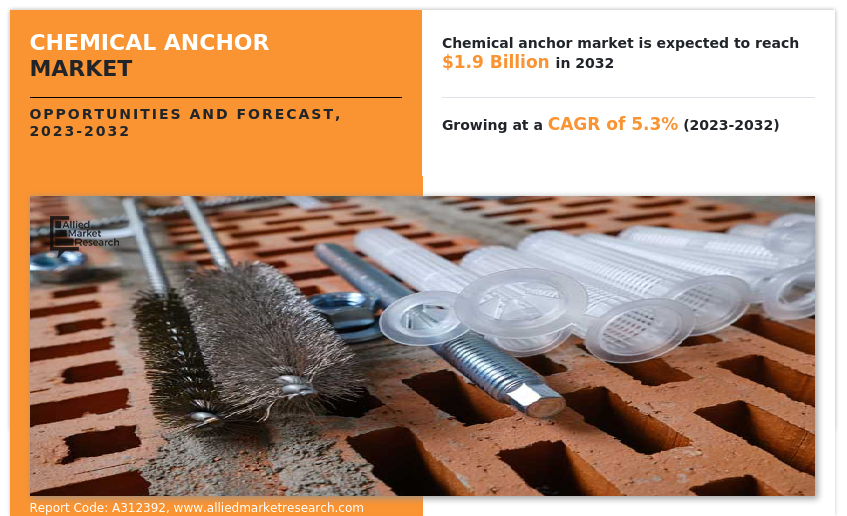
Chemical anchor is a specialized adhesive used in construction to secure heavy loads into materials like concrete. Comprising resin and hardener components, they create a robust bond through a chemical reaction. Ideal for applications such as structural support or fastening steel elements, chemical anchors offer versatility and durability. Their chemical curing process ensures a reliable bond resistant to environmental conditions. Widely used in construction, these anchors provide superior load-bearing capabilities compared to traditional mechanical fasteners, enhancing structural stability and safety in various building projects.
Key Takeaways:
- The report provides competitive dynamics by evaluating business segments, product portfolios, target market revenue, geographical presence and key strategic developments by prominent manufacturers.
- The chemical anchor market is fragmented in nature among prominent companies such as Hilti, Sika AG, 3M, ITW Red Head, Fischer Group, Stanley Black & Decker, BASF SE, Fosroc, Henkel AG & Co. KGaA, and Anchoring Systems Inc.
- The study contains qualitative information such as the market dynamics (drivers, restraints, challenges, and opportunities), key regulation analysis, pricing analysis, and Porter’s Five Force Analysis across North America, Europe, Asia-Pacific, LAMEA regions.
- Latest trends in global chemical anchor market such as undergoing R&D activities, regulatory guidelines, and government initiatives are analyzed across 16 countries in 4 different regions.
- More than 3,000 chemical anchor-related product literatures, industry releases, annual reports, and other such documents of key industry participants along with authentic industry journals and government websites have been reviewed for generating high-value industry insights for global chemical anchor market.
Market Dynamics:
Growing population base has led to rapid urbanization in both developed and developing economies such as the U.S., China, and India. This has increased government spending on architecture sector to develop various upcoming infrastructure projects. For instance, according to a report published by the National Investment Promotion and Facilitation Agency, the infrastructure activities accounted for 13% share of the total foreign direct investment (FDI) inflows in 2022. Furthermore, rapid development of water supply, sanitation, urban transport, schools, and healthcare are aiding the growth of the building & construction sector. Chemical anchors play a crucial role in building and construction by providing a reliable method for securely attaching structural elements to concrete or masonry surfaces. These anchors are used when traditional mechanical fasteners, such as screws or bolts, are not sufficient to meet the load-bearing requirements or when there is a need for a more aesthetically pleasing finish. Moreover, chemical anchors are used to secure expansion joint systems on bridges, allowing for movement while maintaining structural integrity. This may act as one of the key drivers responsible for the growth of the global chemical anchor market.
Furthermore, increasing awareness and emphasis on sustainable construction practices have led to the adoption of eco-friendly building materials and construction methods. For instance, according to an article published by the U.S. Green Building Council in 2022, the U.S. green building industry is considered as a high-revenue industry and has achieved a total revenue of $88billion in 2022. Chemical anchors, with formulations that minimize environmental impact and contribute to the longevity of structures, align with the sustainability goals of the construction industry. This eco-friendly aspect acts as a positive driver of the market.
However, chemical anchors offer numerous advantages in several end-use sectors. However, there are certain health hazards associated with the use of volatile organic compound (VOC)-containing chemical anchors. For instance, high levels of VOCs in chemical anchors could particularly affect asthma and sinusitis patients. Furthermore, VOCs can cause severe irritation to the throat and eyes, and a burning sensation to the nasal membranes. Some VOCs can even cause cancer if exposed beyond maximum concentration limits. Furthermore, several environmental agencies such as the United States Environmental Protection Agency (U.S. EPA), European Union (EU), and others have laid down strict acts and regulations for the use of VOC-containing products. For instance, the United States Environmental Protection Agency (U.S. EPA) regulates VOCs at Federal level in 40 CFR 59, which is the National Volatile Organic Compound Emission Standards for consumer and commercial products. These factors together retrain customers from purchasing VOC-containing chemical anchors, thus hampering the market growth.
On the contrary, rise in penetration of e-commerce and digital platforms is transforming the distribution and procurement channels for construction materials, including chemical anchors. According to a report published by the U.S. Department of Commerce in 2022, the construction e-commerce sales have reached around $8 trillion in 2022 and are expected to remain lucrative sector for e-commerce businesses in the U.S for the next five years. Online platforms make it easier for contractors and construction professionals to access a wide range of products, compare specifications, and make informed purchasing decisions. This shift in the distribution landscape creates new avenues for market players to reach a broader customer base.
Segment Overview:
The global chemical anchor market is segmented on the basis of product type, resin type, end-user industry, and region. On the basis of product type, the market is categorized into injectable and capsule. By resin type, the market is classified into epoxy, vinyl ester, methyl methacrylate (MMA), polyester, hybrid, and others. On the basis of end-user industry, it is divided into building and construction, oil & gas, marine, telecommunications, automotive, and others. Region wise, the market is studied across North America, Europe, Asia-Pacific, and LAMEA.
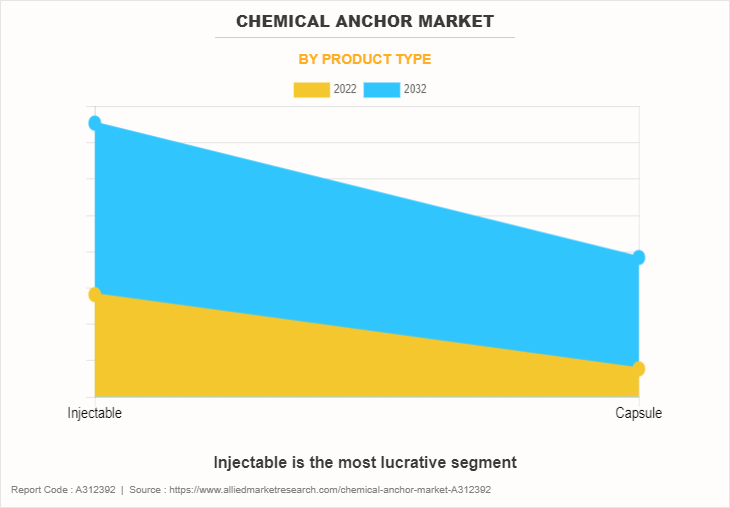
Chemical Anchor Market, By Product Type
In 2022, the injectable segment was the largest revenue generator, and is anticipated to grow at a CAGR of 5.4% during the forecast period. This is attributed to the fact that injectable chemical anchors are user-friendly and easy to apply. The injection system allows for precise placement of the anchor material, making it convenient for installers to apply the adhesive in various construction scenarios. Furthermore, these anchors are suitable for a variety of substrates, including concrete, masonry, stone, and certain types of rock. This versatility makes them applicable in a wide range of construction and anchoring projects.
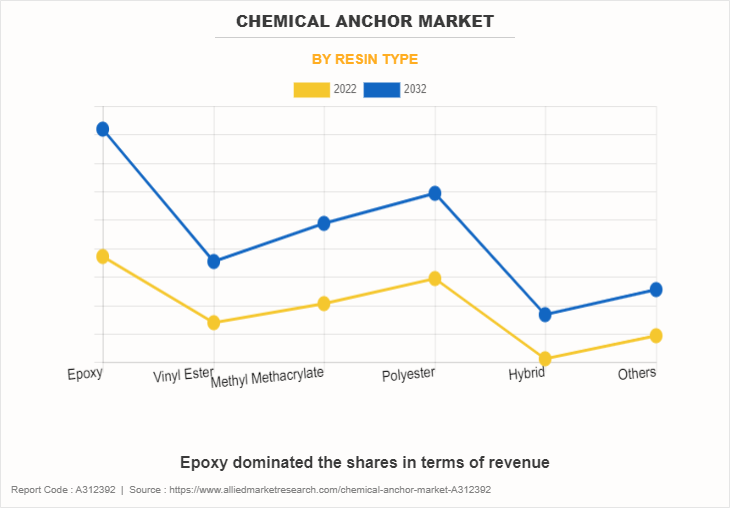
Chemical Anchor Market, By Resin Type
By resin type, the epoxy segment dominated the global market in 2022, and is anticipated to grow at a CAGR of 6.0% during forecast period. This is attributed to the fact that epoxy chemical anchors offer exceptional bonding strength, creating a strong and durable connection between the anchor and the substrate. This high bonding strength is crucial in applications where the integrity of the anchor is essential for structural stability.
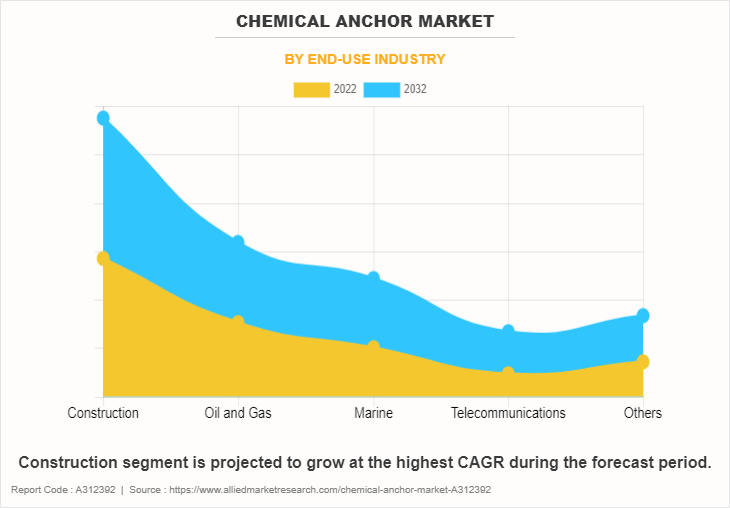
Chemical Anchor Market, By End-Use Industry
By end-user industry, the construction segment dominated the global market in 2022, and is anticipated to grow at a CAGR of 5.8% during forecast period. This is attributed to the fact that the demand for chemical anchors is growing in the construction sector due to several factors that contribute to their advantages and versatility in various applications. In addition, these anchors play a crucial role in securely fastening and anchoring objects to base materials such as concrete, masonry, and stone. They can further be used in a variety of substrates, including concrete, masonry, stone, and certain types of rock. This adaptability makes them suitable for different construction scenarios and materials.
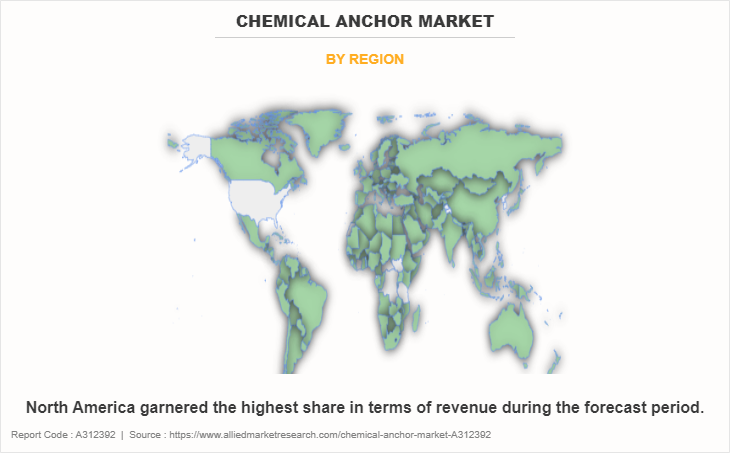
Chemical Anchor Market, By Region
The Asia-Pacific chemical anchor market is projected to grow at the highest CAGR of 6.2% during the forecast period. One of the primary drivers is the extensive infrastructure development and urbanization in Asia-Pacific. The rapidly growing economies such as China, India, and Southeast Asian countries are investing heavily in construction projects, including residential, commercial, and industrial structures. Chemical anchors play a crucial role in ensuring the stability and durability of structures, thus witnessing increased demand.
Moreover, the construction industry's robust growth in the region is a major driver of the chemical anchor market. Governments and private entities are investing in various construction projects, including bridges, highways, tunnels, and high-rise buildings. Chemical anchors are used for structural reinforcement, providing a reliable solution for critical applications in the construction sector.
Competitive Analysis:
The global chemical anchor market profiles leading players that include Hilti, Sika AG, 3M, ITW Red Head, Fischer Group, Stanley Black & Decker, BASF SE, Fosroc, Henkel AG & Co. KGaA, and Anchoring Systems Inc. Other key players involved in the manufacturing of chemical anchors includes MKT Fastening, Power Fasteners, Illinois Tool Works Inc., EJOT, Chemifix Products Ltd., Fixfast, Ripple India, and Leviat B.V. The global chemical anchor market report provides in-depth competitive analysis as well as profiles of these major players.
Industry Trends:
- The chemical anchor market is witnessing robust growth, driven by the increasing demand for secure and high-performance fastening solutions in the construction sector. Government statistics show a significant rise in infrastructure development, particularly in emerging economies, which has boosted the use of chemical anchors in projects like bridges, tunnels, and high-rise buildings. For instance, the U.S. Census Bureau reported a 7% increase in infrastructure spending in 2023, a key factor contributing to the expansion of the chemical anchor market. This growth is further supported by the demand for earthquake-resistant construction methods, where chemical anchors offer superior bonding strength.
- In Europe, regulatory standards promoting sustainable construction practices are also shaping the market. The European Union's revised Construction Products Regulation (CPR) emphasizes the use of eco-friendly materials and processes, leading to innovations in low-emission chemical anchors. These trends are being bolstered by government incentives for green building initiatives. According to the European Commission, the demand for chemical anchors in infrastructure and retrofitting projects increased by 5% in 2022, with sustainability considerations becoming increasingly important for both public and private projects.
- In addition to infrastructure, the chemical anchor market is benefiting from a rise in renovation and retrofitting activities, particularly in older buildings. Government programs, such as India’s Smart Cities Mission, which targets urban renewal, have created new opportunities for the market. With global construction activity projected to continue its upward trend, the chemical anchor market is expected to grow steadily, supported by regulatory frameworks and the increasing complexity of modern construction needs.
Key Benefits For Stakeholders
- This report provides a quantitative analysis of the market segments, current trends, estimations, and dynamics of the chemical anchor market analysis from 2022 to 2032 to identify the prevailing chemical anchor market opportunities.
- The market research is offered along with information related to key drivers, restraints, and opportunities.
- Porter's five forces analysis highlights the potency of buyers and suppliers to enable stakeholders make profit-oriented business decisions and strengthen their supplier-buyer network.
- In-depth analysis of the chemical anchor market segmentation assists to determine the prevailing market opportunities.
- Major countries in each region are mapped according to their revenue contribution to the global market.
- Market player positioning facilitates benchmarking and provides a clear understanding of the present position of the market players.
- The report includes the analysis of the regional as well as global chemical anchor market trends, key players, market segments, application areas, and chemical anchor market growth strategies.
Chemical Anchor Market Report Highlights
| Aspects | Details |
| Market Size By 2032 | USD 1.9 billion |
| Growth Rate | CAGR of 5.3% |
| Forecast period | 2022 - 2032 |
| Report Pages | 509 |
| By Product Type |
|
| By Resin Type |
|
| By End-Use Industry |
|
| By Region |
|
| Key Market Players | Stanley Black & Decker Inc., Sika AG, Hilti, 3M, Fischer Group, LLC, Fosroc, Inc., ITW Red Head, BASF SE, Henkel AG & Co. KGaA, Anchoring Systems Inc |
Analyst Review
According to the CXOs of leading companies, the chemical anchor market is influenced by a combination of factors, ranging from the dynamic growth in construction and infrastructure projects to the evolving landscape of safety regulations and technological advancements. Stakeholders in this market must stay abreast of these drivers, adapt to changing industry dynamics, and continue to innovate to meet the evolving needs of the construction sector. As the global construction industry continues to expand, the chemical anchors market is poised for sustained growth, driven by the crucial role these products play in ensuring the safety, durability, and integrity of structures.
Growing construction industry, rising investments in infrastructure, and focus on safety and stability are the upcoming trends of chemical anchor market in the world.
Construction is the leading application of chemical anchor market.
North America is the largest regional market for chemical anchor.
The global chemical anchors market valued was for $1.2 billion in 2022 and is estimated to reach $1.9 billion by 2032, exhibiting a CAGR of 5.3% from 2023 to 2032.
The global chemical anchors market profiles leading players that include Hilti, Sika AG, 3M, ITW Red Head, Fischer Group, Stanley Black & Decker, BASF SE, Fosroc, Henkel AG & Co. KGaA, and Anchoring Systems Inc.
Loading Table Of Content...
Loading Research Methodology...



